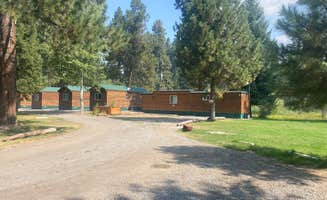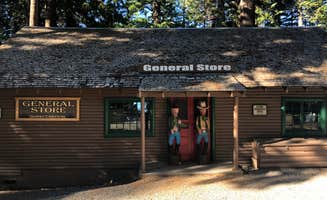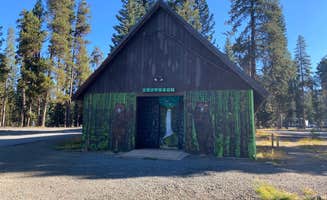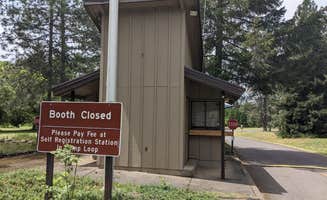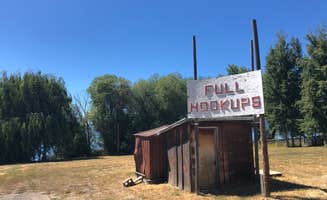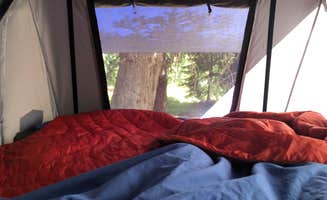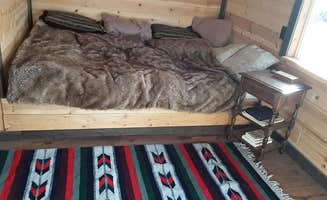Campsites near Fort Klamath sit at elevations ranging from 4,000 to 4,500 feet, creating moderate summer temperatures that average 75-85°F during peak season. The area receives approximately 12 inches of rainfall annually, predominantly in winter and spring months. Most campgrounds in this region offer access to clear mountain streams and alpine lakes while providing varied proximity to Crater Lake National Park.
What to do
Explore historic logging exhibits: At Collier Memorial State Park Campground, visitors can walk to an extensive logging museum showcasing vintage equipment. "Follow the walking trail to the logging museum. Logging equipment, buildings, train cars (all outdoors) with guided tours and a gift shop. The nearby river is small and beautiful," notes Jessica P. The museum is free to the public and open regular hours during the summer season.
Canoe crystal-clear waterways: Many campgrounds provide direct water access for paddling. At Rocky Point Resort, campers can bring their own equipment or rent from the resort. One visitor mentioned, "My partner made a 5-mile loop on the lake in just over 2 hours around and through a National Wildlife Refuge on a paddle board." The clear, shallow waters are ideal for beginners and experienced paddlers alike.
Stargaze without light pollution: The high elevation and minimal development make this area perfect for night sky viewing. "We were able to see soooo many stars in the sky!!" exclaimed one camper at Collier Memorial. The dark skies away from major cities provide exceptional visibility for astronomical observation, especially during new moon phases when skies are darkest.
What campers like
Natural swimming areas: Diamond Lake offers dedicated swimming areas ideal for families with children. One camper shared, "The tent sites are right by the lake and are so so pretty. The hosts are super friendly and the store has everything you need." The shallow entry points and sandy shores make these spots popular during warmer summer days.
Proximity to Crater Lake: Campgrounds serve as convenient basebases for exploring the national park. As one visitor mentioned, "Stayed here while visiting Crater Lake NP. Very nice and quiet! Easy to find and very nice staff." Most sites are within 20-45 minutes of the park entrance, allowing for early morning access before day-visitor crowds arrive.
Diverse accommodation options: Beyond traditional tent sites, Fish Lake Resort offers a range of glamping opportunities. "Yep, we went camping in the snow. The campsites were cleared of snow and we had a beautiful overlook of the lake," noted Kathlene S. Many sites offer yurts and cabins that remain available into shoulder seasons when temperatures drop.
What you should know
Mosquito prevalence: The wetland areas around Fort Klamath create ideal breeding conditions for insects. "Be prepared to fend off mosquitoes if you're going in the summer!" warned a visitor to Diamond Lake. Bringing proper repellent and protective clothing is essential, particularly during early summer months when populations peak.
Limited cell service: Many campgrounds have spotty connectivity. "Forget Wi-Fi - as even the enhanced barely works - but we didn't care - it was a perfect getaway," shared Linda L. at Crater Lake Resort. Some campgrounds have slightly better reception at higher points in the camping areas.
Seasonal operation: Most facilities close during winter months. Whiskey Springs Campground is among the few that remains open year-round, though with limited amenities. "Midweek in June and only one other site occupied? Really comfortable campground," noted Gary K. Most campgrounds operate from late May through early October, with peak availability in July and August.
Tips for camping with families
Playground access: Joseph H. Stewart County Park features multiple play areas throughout the property. "There are paved bike paths, playground, rentals for the lake," mentioned Sasha R. The playground structures are typically located near restroom facilities and central camping areas.
Wildlife viewing opportunities: Several campgrounds offer chances to spot local fauna. "Chipmunks are everywhere and for some reason people life the goods to protect their cars," cautioned one visitor to Collier Memorial. Teaching children wildlife observation ethics enhances the educational value of these encounters.
Water safety considerations: Lakes in the area often have designated swimming zones with gradual entry points. "It's a beautiful slow moving river right behind our camp site. Took the dogs for a walk and took in great views of tall pines, trout in the river and very well maintained grounds," reported Don A. about glamping near Fort Klamath, Oregon. Parents should note that most natural swimming areas lack lifeguards.
Tips from RVers
Site selection priorities: At many campgrounds, some sites offer significantly better positioning than others. "We stayed in site # B8. It was a big site with a beautiful BIG Red Cedar tree," shared a camper at Joseph Stewart State Recreation Area. Sites on outer loops typically provide more privacy and better views than interior locations.
Hook-up variability: Electrical and water connections differ between campgrounds and even between loops within the same property. "I booked a pull through spot online, when I arrived the owner walked around with me recommending available spots with a better view," reported Matt D. at Rocky Point Resort. RVers should confirm specific amenities when booking as many glamping accommodations near Fort Klamath, Oregon require self-contained units.
Waste disposal logistics: Dump stations are not available at all campgrounds. "Cost to dump grey water is $25, I've never seen a fee this high. I'd gladly pay $10," noted one camper at Rocky Point Resort. Planning ahead for waste management can prevent unexpected charges when departing.


